1985 French Grand Prix race report
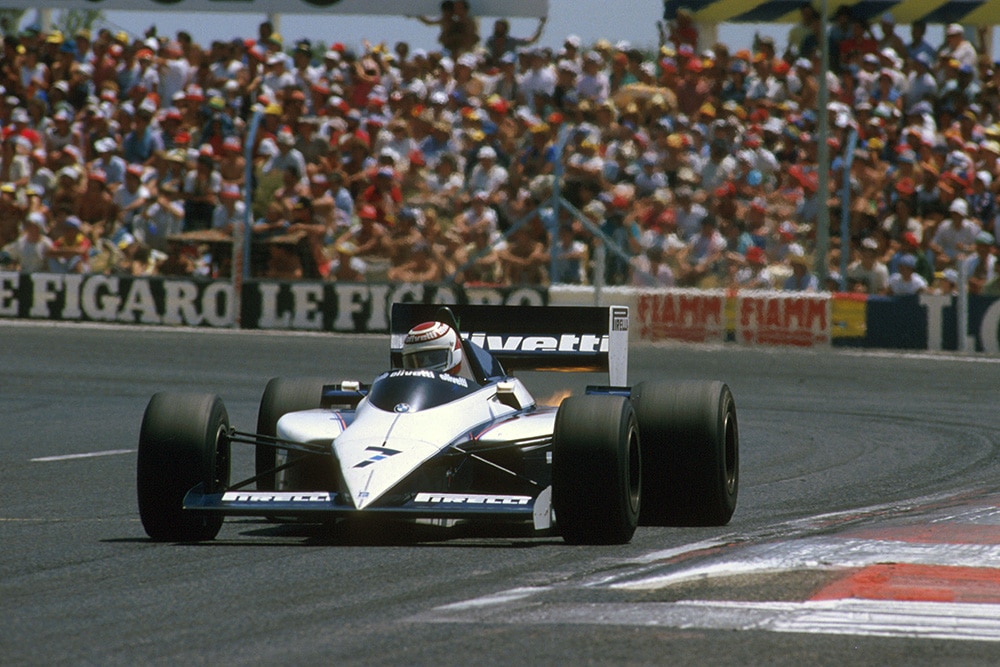
Nelson Piquet claimed a first win of the season for Brabham
Motorsport Images
Normality returns
Castellet, July 7th
With the Grand Prix season around its half-way point everything looked to be set fair as the Formula One teams assembled at the Circuit Paul Ricard, on the arid plain above the Mediterranean seaside resorts of Bandol and La Ciotat. The Honda engine men were happy with the progress that their revised V6 had made in the North American races, Ferrari was as strong as ever, Lotus was revelling in its new-found enthusiasm, sparked off by the arrival of Ayrton Senna in the team, McLaren, while not dominant like last year, was never far from the front, and Renault was entering on a new phase with a brand new car. Brabham and BMW were just being their philosophical selves, hoping that one day Pirelli could match Goodyear on the tyre front, or at the least that Goodyear would stumble and let the Italian tyre giant catch up.
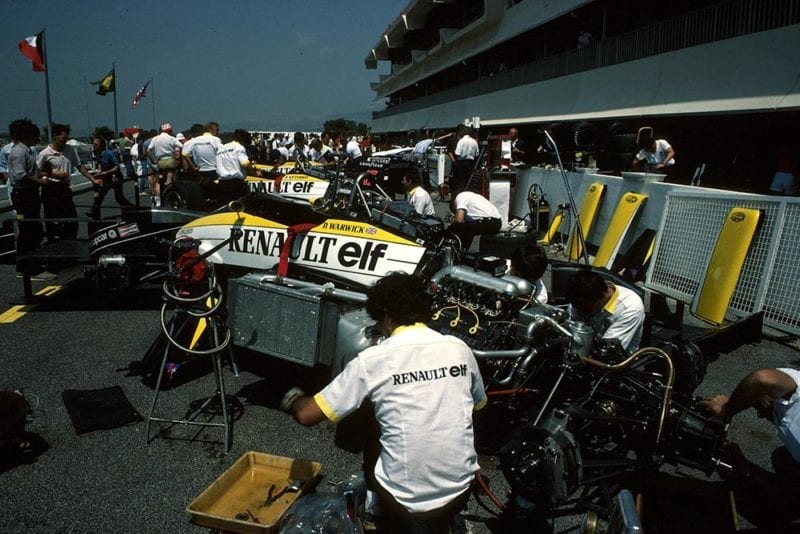
Renault mechanics work on Derek Warwick’s car
Motorsport Images
In the lower echelons Ken Tyrrell was viewing the Renault turbo power in the back on the new 014 with slight apprehension, Toleman and Brian Hart were still trying to get back into their 1984 routine, and Zakspeed was feeling much happier now it had completed its second car. John Macdonald was wondering how long he could hold out against adversity, as his RAM cars had been having more than their fair share of troubles.
With the return to high speed, for if it has nothing else, the Paul Ricard circuit has the fastest straight in Formula One, the new equation for engineers to juggle with was the between sheer mph down the long straight, aided by levelling-off the aerodynamics, and adhesion round the corners where “downforce” from aerofoils was essential. Sad was the day when FISA banned movable aerodynamic devices, for we were on the threshold of some interesting innovations. To be able to “feather” the “down-force” generation on the long straight, and then move them into “course-pitch”, either by driver control or automatically, for braking and cornering, would have produced some dramatic results on a circuit like Paul Ricard. So Friday morning testing saw the engineers juggling with the variables to produce the best lap times. As the circuit is used nearly all the year round for testing purposes there are not many drivers who need to learn the way round.
It was merely a matter of aclimatising yourself to detail differences of adjustments, unless of course you were Martin Brundle who was giving the Tyrrell-Renault V6 turbo car its first public outing. He had to learn a whole new technique of driving, with more thrown in for good luck, though weighing 600 kgs, against the 540 kgs of the Cosworth powered Tyrrell, and having the Renault boost kept low to begin with, the power to weight ratio of the Tyrrell 014 was not startling, but none-the-less it enabled Brundle to knock four seconds a lap off the times done by the Tyrrell 012, but this was eight seconds off the pace that the front runners were setting. It is not easy to keep up with the front runners in Formula One.
Within the teams there had been some chaQges made, Frank Williams’ teammanager had. left and joined the Toleman team; the Didcot-based team had produced a brand new car for Nigel Mansell to replace the one he crashed in Detroit, Team Lotus had repaired ,ennais Detroit-crashed car and made it”‘ihe T-car with the Brazilian taking over the latest Lotus 97T, which is number 4 and had previously been the Tear. Ferrari produced two brand new cars for Alboreto (083) and Johansson (084) which had revised geometry front suspension, while . two of the earlier cars were brought along as T-cars, and Renault had the first of its drastically-revised RE60 cars for Tambay, the model now being RE60B. About the only thing unchanged was the basic carbon-fibre-composite monocoque, there being changes to suspension members, brakes, engine mountings, gearbox casing, aerofoil mountings, side pods and bodywork, all aimed at reducing weight, increasing stiffness, reducing drag and improving handling.
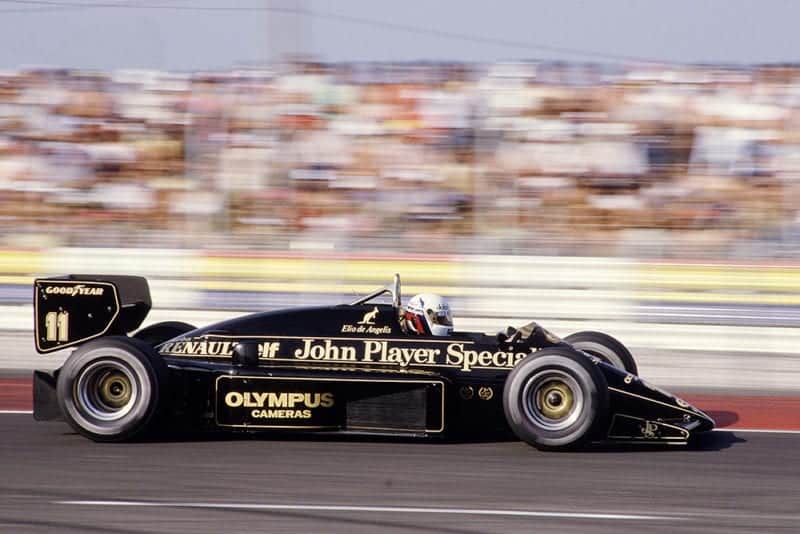
Elio de Angelis qualified his Lotus 7th
Motorsport Images
On the weight question the new car was a huge success, it actually tipped the scales at 540 kgs during one official weight check, which is as close to the lower limit you can get without actually infringing the rules! Brabham, or rather BMW, was about to experiment openly with American Garrett turbochargers in place of its normal German KKK units, while Alfa Romeo was still using two small KKK units in place of its own turbochargers which have never been really successful. Ligier had a brand new car for Laffite, this being the second of its lighter models, but still to the normal JS25 specification, with Renault power.
It was not long during the Friday morning test session before the Ferrari team found it was going the wrong way with its suspension alterations, which had seemed to be advantageous on its private test-track, but the French GP was being run at Paul Ricard, not at Fiorano. By the time the serious business of qualifying began in the after-noon there was a bit of an air of Maranello shambles about the top end of the pit lane. It is very difficult to back-track in the middle of a test session or a qualifying period, even if you are convinced you have gone the wrong way, which Ferrari was not. Lotus and Williams were exudiJ!g_.confidence, as were their lead drivers Senna and Rosberg, while that canny pair at McLaren were not giving anything away, as usual, apart from the well-rehearsed PR platitudes. However, one team that hasn’t been saying much for a long time, mainly because it has had nothing to say, is Brabham.
If Nelson Piquet is not near the front with one of Gordon Murray’s Brabham cars there is clearly something very wrong. Whenever you take a look out on the circuit the BMW power is clearly there, especially the “grunt” that gets the modern Formula One car from 140 mph to 190 mph. It is pointless to ask Piquet or Murray what is wrong, because if they knew and could do something about it, they would be up the front where they belong. It is equally pointless asking Mr Ecclestone what is wrong with his team, because you can rest assured that he has already asked Murray and Piquet, and if they don’t know then little Bernie is unlikely to know.
Not before time, summer arrived in Europe and the dusty plain on which the flat Paul Ricard circuit has been contrived was very hot. Fortunately the dreaded Mistral wind was in a good mood and was blowing comfortably and happily down the long Mistral straight where cars are on full-song for nearly one mile. This helped the engines quite considerably, but made the cars a bit twitchy as they swept into the Signes curve at round 200 mph. In addition there was a nasty bump in the surface just as the cars changed direction, which lifted the rear wheels slightly and the wind then aggravated things, which called for a lot of concentration and bravery on the part of the drivers, especially those who were clocking well over 200 mph as they reached the 150 metre marker board before the bend. From sniffing about the pits during the morning testing I took the opportunity to go out on the back of the circuit to watch qualifying from the entrance to the Signes curve. Mainly it was to “see” the 220 mph that some drivers had been talking about, but more precisely to look at the speed read-outs being recorded by beam-timers set up by Brabham, McLaren, Lotus, Ferrari and Alfa Romeo.
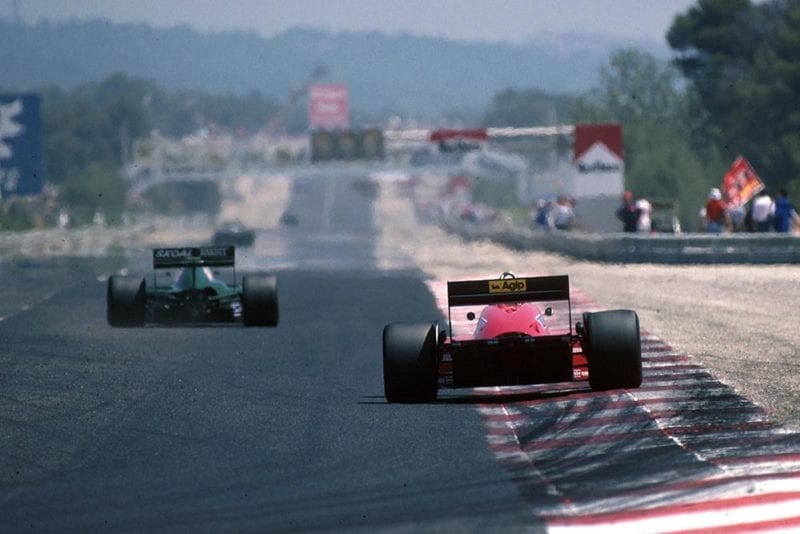
Ferrari follows RAM down the Mistral straight
Motorsport Images
It would be too much to expect them all to agree, because we are talking about speed measured over a few yards, using different makes of apparatus, but the discrepancy seemed to be a maximum of three miles per hour from the most optimistic to the most pessimistic, which was not bad in a 200 mph band. Taking a general view the front runners were arriving at 205 to 207 mph, while the “slow” back markers were down in the 190 to 192 mph bracket. Nobody was being brave enough (or foolhardy enough) to try to take the curve without lifting, though Rosberg felt he should be capable of it. With a six-speed gear cluster in the Williams gearbox he snicked down from sixth to fifth as he turned into the curve, which even with very close ratios, didn’t knock that much off his speed. It was definitely “hero time” for the men of Grand Prix racing, while the “boys” didn’t do badly to go into the corner at 185 mph. On the outward leg on the long thin circuit it was “hero time” through the ess-bend after the pits straight, and all the front runners were going into the ess without lifting off, at 175-180 mph or thereabouts. By comparison the rest of the circit was “Mickey Mouse” stuff, which gave a lap speed of 140 mph overall, which is impressive, but not as impressive as 158 mph average round Silverstone for example.
The Ferrari handling troubles were nothing compared to the reality of the qualifying hour, for both Alboreto and Johansson had serious engine failures. The Swede took to his spare car but was never in the running. To say that Ayrton Senna made fastest lap in qualifying has become commonplace in 1985 and he was in a class of his own with a time of 1 min 32.835 sec.
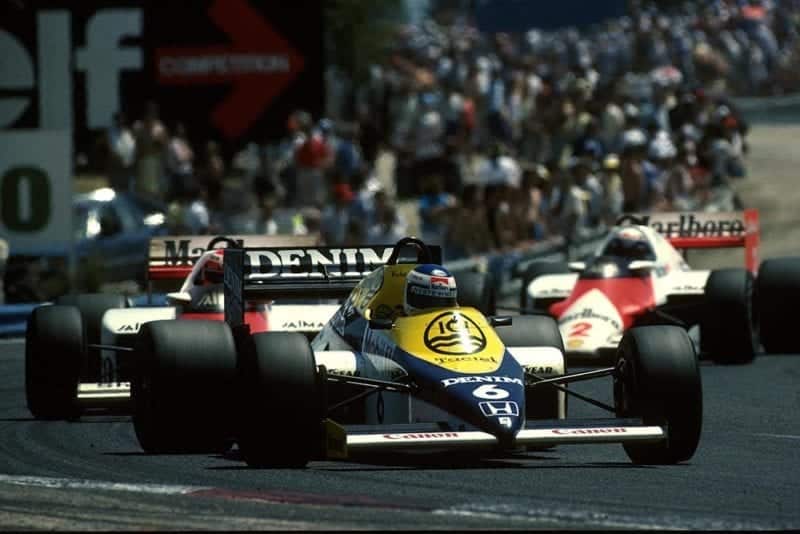
It was pole for Williams’ Keke Rosberg
Motorsport Images
Next·came Rosberg with 1 min 33.484 sec, followed by the two McLarens in the 1 min 33 sec bracket and then Piquet with 1 min 33.981 sec. Now that was interesting; though the adhesion of his Pirellis through the fast ess-bend may not have looked to be the equal of the Goodyears, he was not lifting off, nor was he down much at Signes. If you can take really high-speed corners with confidence there cannot be much wrong! Down at the bottom end the last surviving Cosworth powered car, the Tyrrell of Stefan Bellof, was simply out of breath, and the Motori Moderni V6 turbocharged engine in the Minardi never did sound “clean” and was very slow. Martin Brundle was doing his best with the new Tyrrell 014 but was finding that when the Renault engine was given some boost and produced power it pushed the front of the car into enormous “understeer” attitudes. This was something that everyone has had to find out about when changing from 500 bhp Cosworth power into the new world of real power, and as Ken Tyrrell said wryly ” … and no one is going to tell us what to do about it, are they?” He was dead right. The result was that the Tyrrell-Renault 014 qualified at virtually the same speed as Palmer in the Zakspeed, from which you can draw your own conclusions. Brundle was in Tyrrell 014/1 while the brand new 014/2 was on hand in case of emergencies, just as ZAK 841/02 was in the German pit.
Saturday was another hot day, but with slightly less wind down the straight, though speed-trap times did not show much difference. Ferrari went back to square one on its suspension modifications, and immediately Alboreto was up at the front, but Johansson was still in trouble with engines. During the morning Nigel Mansell had a spectacular accident when his left rear tyre deflated and disintegrated as he reached the end of the back straight going at a good 200 mph. The rear aerofoil was torn off as was the left rear suspension and, totally out of control, the Williams ploughed into the catch-fences. A supporting pole took the left front suspension off and the wheel and tyre arced over and struck Mansell on the helmet.
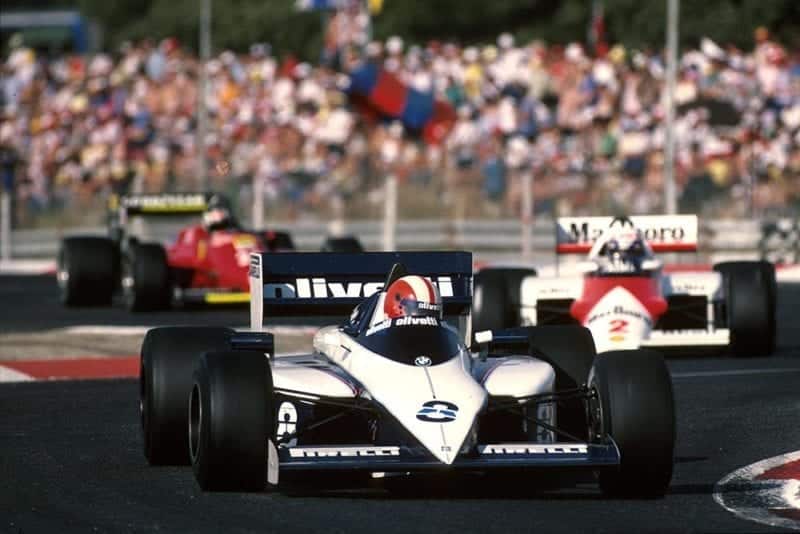
Marc Surer qualified 13th for Brabham
Motorsport Images
The wreckage came to a stop and miraculously the driver was unhurt apart from severe concussion, which says a lot for the construction of modern Grand Prix cars and catch-fences and run-off areas in general. Mansell was taken to, Marseilles hospital to check his head, and’ after being kept under observation through Saturday night he was allowed to return to his Isle of Man home on Sunday, there being no question of him taking part in the French Grand Prix.
Qualifying
Qualifying for grid positions took place as usual between 1 pm and 2 pm on Saturday afternoon, but a change in the wind and even higher temperatures kept lap times down a bit, so that the only real improvements were made by those who had not got it all right on the previous day. With the circuit being “long” by today’s standards there was not too much trouble with baulking, and most drivers got a good clear run on their one-lap qualifying tyres. Senna did not go as quick as he had the day before, but Rosberg went a whole second quicker, which put him up on pole-position. Senna went out again to do something about it, but before he reached the end of his fast lap the Renault engine blew up and that was that, he had to settle for second fastest time with his Friday time. Rosberg’s time of 1 min 32.462 sec giving him an average speed of 226.211 kph (140.561 mph). Alboreto and Prost were close to the front, in third and fourth places, respectively, and then came Piquet, still up near the front on his Pirelli tyres. Johansson was still in trouble with engines in his Ferraris and could do no better than a lowly 16th, which meant he would take 15th place on the grid, with Mansell’s withdrawal. Of the new Renault the less said the better, though its performance was not given the best chance as Tambay was feeling decidedly “queasy” and was no faster than Warwick with the older car. Once it became obvious that there was not much wrong with the Pirelli tyres on Piquet’s Brabham, nor anything wrong with the BTS4 or the BMW M-power, the opposition suddenly found all manner of things wrong with their Goodyear tyres! How else could they be beaten by a Pirelli- shod car?
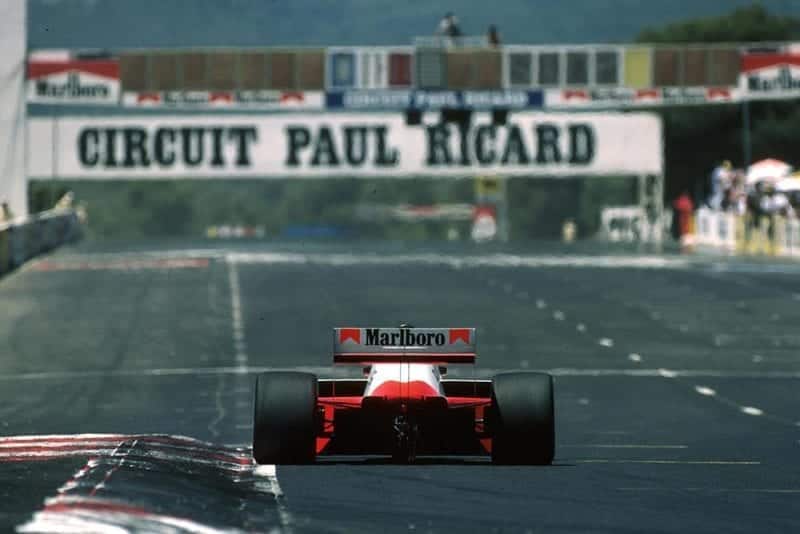
The McLaren’s lined up 4th and 6th after qualifying
Motorsport Images
Sunday was another “scorcher” and the slowness of the traffic entering the main gate suggested a 100,000 crowd at least, but it turned out that it was simple inefficiency at the ticket checks that made the crowd of some 54,000 seem like twice as many! With the race due to start at 1.15 pm the morning warm-up session was bright and early and before the sun had really warmed up, so it was all a bit inconclusive, especially as regards tyre choice, though mechanical problems are the same hot or cold! Both Ferrari drivers had opted to race their earlier cars, with the old-type front suspension, Tambay was happy to race the new RE60B and Brund.le was keen to continue his learning about Renault turbo power. As so often happens when everyone runs in full race trim, with full petrol load, race- duration tyres, duration boost-pressures and so on, the McLaren-Porsches suddenly have to be taken seriously, though this time they were accompanied by Nelson Piquet also looking serious in the Pirelli-shod Brabham BTS4, using a Garrett turbocharger on its BMW engine, as was Surer’s car.
In spite of pre-race information giving the race length as 54 laps, when it came to the event the· actual race was due to be raced over 53 laps! Such is the “professionalism” of FISA /-FOCA. With Mansell’s Williams withdrawn it left.only 25 cars to assemble on the grid;-‘:ind all those lower than eighth place moved up a space. After one warm-up lap Piquet returned hurriedly to the pits, concerned about the “feel” of the Brabham’s gearbox, and quickly transferred to the Tear, which was all ready for just such an emergency. There was still some uncertainty .among ihe Goodyear runners as to exactly what they should be using, some, like Warwick, opting to run on soft tyres, planning to make a pit-stop for a new set during the race.
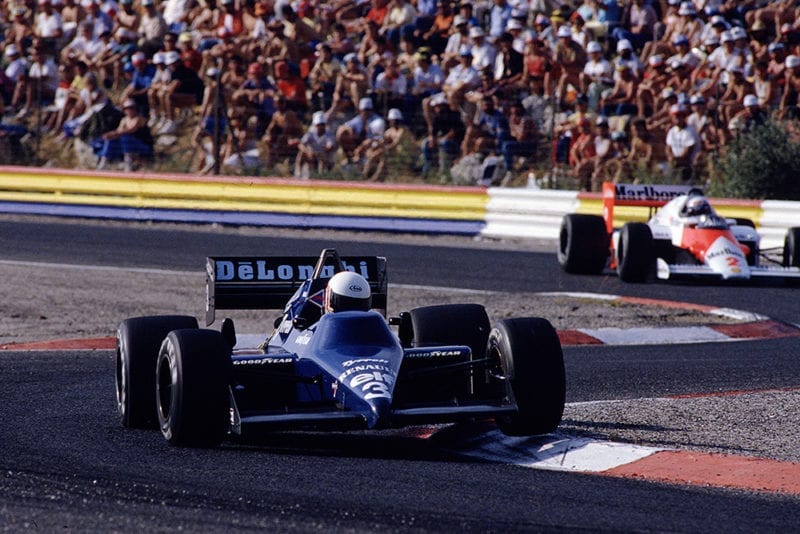
Martin Brundle retired on lap after his Tyrrell developed gearbox issues
Motorsport Images
From the green light it was Rosberg and Senna away in front, heading for the first ess-bend wheel-to-wheel, but nobody frightens Rosberg into giving way, not even Ayrton Senna, and down the back straight the order was Rosberg, Senna, Piquet, Alboreto, de Angelis, Lauda, Prost and the rest. On lap 2 the order was unchanged, except that a distinct gap had appeared between Piquet and Alboreto, but the gaps between Rosberg, Senna and Piquet were unchanged. This interesting situation became even more interesting on lap 3 for Piquet had closed up visibly on Senna, who was making no ground on the flying Rosberg. The three of them were pulling away steadily from the rest of the fast runners, still led by Alboreto, but on lap 6 the number one Ferrari went by in a cloud of smoke as the engine expired, leaving de Angelis to take fourth place, with Lauda and Prost following. After a gap came Warwick leading Berger, Tambay, Boutsen and Surer, with Johansson coming up behind from his lowly starting position. As the leaders went down the back straight on lap 7 Piquet had his Brabham’s need.le nose right under the Lotus gearbox and by the end of the lap the Brabham was in second place. This was the Brabham I Piquet combination we knew so well in 1983, and both were now really on-song. Even Rosberg could do nothing about the crafty Brazilian and by lap 11 Piquet was ready to pounce, which he did round the Signes curve. To Piquet fans this was so absorbing that it almost went unnoticed that Senna had gone by on lap 10 down in eighth place, travelling at a greatly reduced speed, his Lotus-Renault stuck in third gear. By the time he got to the pits he was back in 12th place and after the Lotus mechanics had cured the trouble the black and gold number 12 roared back into the race a lap behind the leaders and in last place, but going as hard as ever.
From the end of lap 11 Piquet never looked like being troubled, and he gave one of those masterly displays where he turns down the boost pressure, seems to be coasting quietly along, yet still increasing his lead over his pursuers who look and sound to be trying everything they knew to stay with him. This race was no exception, for Rosberg had Lauda shadowing him, waiting for him to make a mistake and let the McLaren through, and Prost was sitting comfortably behind the pair of them awaiting developments. Rosberg knew that Lauda was not going to try anything stupid or desperate, and as long as he didn’t make a mistake anywhere it was stale-mate. While Piguet cruised away to an ever increasing lead, without putting any strain on himself or his car ( or his Pirelli tyres for that matter), Rosberg cheerfully kept Lauda at bay, even though the wily old Austrian made attempts to get alongside the Williams as they headed for the end of the back straight. Indeed, once or twice Lauda was so close to the Williams that I wondered if he could see anything at all through the heat from the Honda exhaust pipes. All the while Prost was maintaining a discreet cijstance, holding fourth place, though on the corners he was closing right up with them, as if to let them know they were actually holding him up!
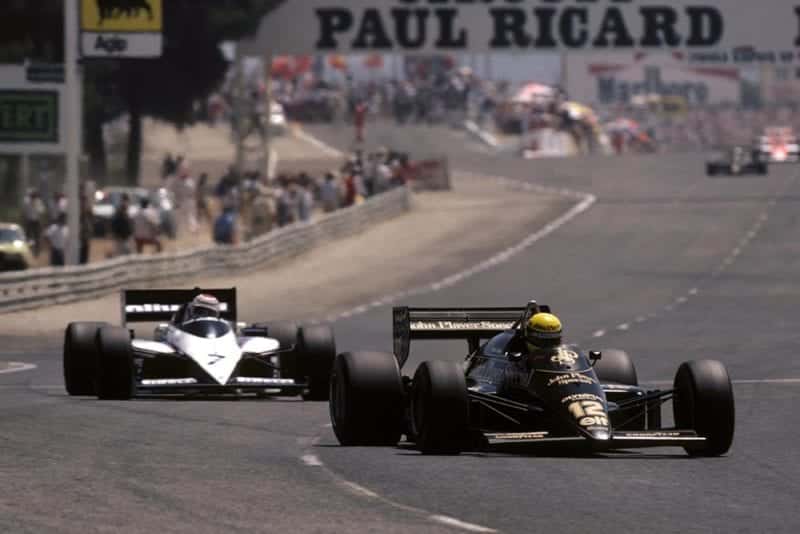
Ayrton Senna leads race winner Piquet
Motorsport Images
As they started lap 13 Lauda suddenly pulled off the racing line, and came to a stop with no drive to the rear wheels and as far as he was concerned his French GP was all over. This gave Prost his opportunity and he closed rapidly on Rosberg and, on lap 39, was by into second place, but Rosberg knew the reason was mainly because he had consumed his tyres, so he dived into the pits and had four new wheels and tyres fitted in an incredible sub-ten second stop, and was back in the race having only lost one place, and that to de Angelis who was plodding round in a safe fourth place, or so he thought. Rosberg was soon back in third place and really flying once more on his new tyres. Way out in front Piquet was cruising, yet maintaining his pace and was so ”feather-foot” down the back straight that his BMW engine was making hardly any sound, especially compared with Rosberg’s Honda engine which was obviously working very hard for the Finn was in his usual “flat out” state. And well he might be, for he was galloping up on Prost’s McLaren at an impressive rate.
With all this excitement among the front runners, there had been a tendency to overlook the rest of the field. Some could well be overlooked, like the two Ligiers that were both out of the race within five laps, Laffite with a turbocharger failure, and de Cesaris with a broken drive-shaft, or Palmer with the new six-speed Zakspeed that was gone from sight by seven laps with engine maladies, and Alliot who scored another “Did Not Finish” for the RAM team. Pierluigi Martini with the Minardi turbocharged V6 was having a bad time, getting in people’s way and eventually colliding with Berger’s Arrows as the Austrian came up to lap him. After rejoining the race with his gearbox operating properly once again, Senna sat behind his team-mate for a while, though a lap down, until he could suffer it no longer and went by to start making up ground on the tailenders. Alas, his progress was cut short very violently when his Renault engine blew up and put him into a spin on his own oil. Martin Brundle had been making good progress with the turbo Tyrrell, disposing of both Alfa Romeos and Fabi’s Toleman-Hart, but then a deranged gearchange mechanism put him out. Warwick had found his “soft” Goodyears had deteriorated quicker than he anticipated and an early stop, on lap 17 to have new ones fitted only saw him in the same trouble some 20 laps later, so he settled to cruise through to the finish. Tambay in the new Renault RE60B ran non-stop but was never within sight of the leaders, almost being in fear of being lapped by Piquet.
As happened at Imola earlier in the year, Stefan Johansson was doing his utmost to save the day for Maranello and had been steadily gaining places throughout the race, until he was in fifth place, but what was more important he could now see de Angelis ahead of him, and though the Lotus was black it was like a “red rag” to the Swede. He really gave it all he’d got and reeled in the Lotus dr;unatically, but meanwhile his fellow Scandinavian was doing equally heroic things. Rosberg was not content with third place, he wanted his second place back and he caught and passed Prost as they were half way round the last lap. The Frenchman made no silly attempts to block the Williams, bowing graciously to a superior force and they took the long Signes curve only a few seconds behind the serene Piguet, whose Brabham-BMW was still running superbly having judged his pace to a nicety without undue strain. It was “vintage Piguet” if one can use such an expression. That was first, second and third places wrapped up, but fourth place was something else. As the Lotus and the Ferrari went down the back straight for the last time, heading for the “Mickey Mouse” twisty bit back to the finishing line, Johansson pulled out of the slipstream to a nicety and was alongside as the two cars peeled off round the long right-hand curve, de Angelis bravely sitting it out with the tightly-woundup Swede, who was on the outside line. It was all over, the Ferrari was fourth and finished just a few feet aheada of the Lotus as they crossed the line, but that was all that was needed.

Piquet sprays the obligatory bubbly with Keke Rosberg (left) and Alain Prost
Motorsport Images
For anyone not paying attention on the last lap of the 1985 French Grand Prix they missed heroic deeds by those two hardcharging Scandinavians Keijo Rosberg and Stefan Johansson. Their teams were proud of them. For the Brabham team, and BMW and Pirelli in particular it was a case of a huge sigh of relief and satisfaction. It had been a long hard struggle to get to where they really belonged, which is at the front. – D.S.J.
